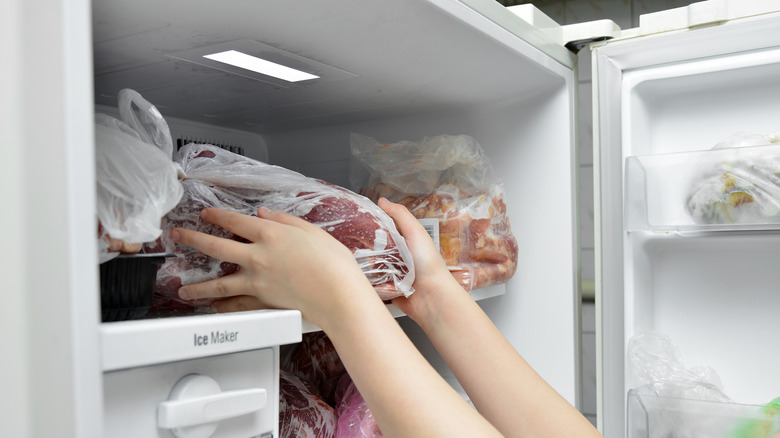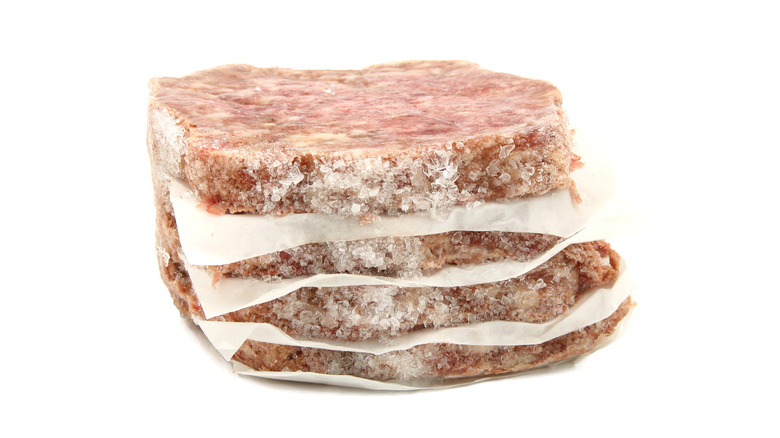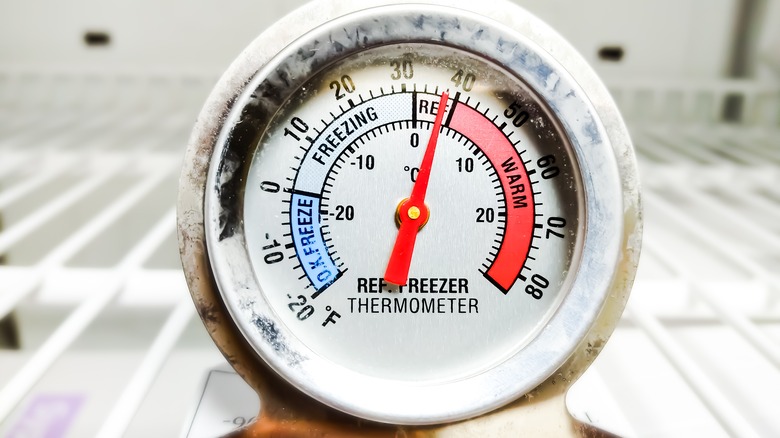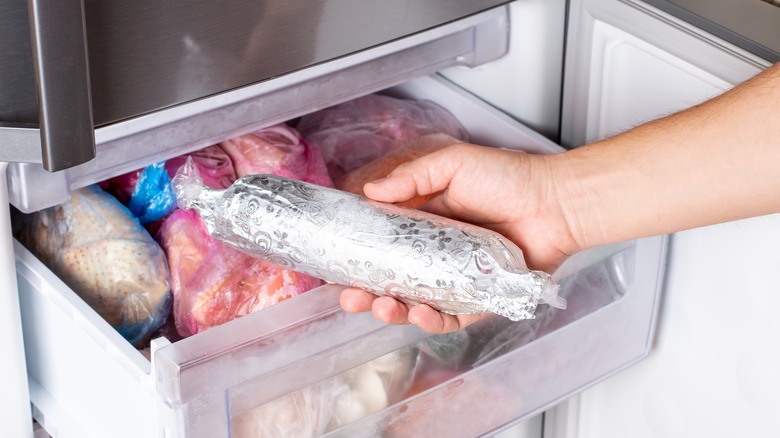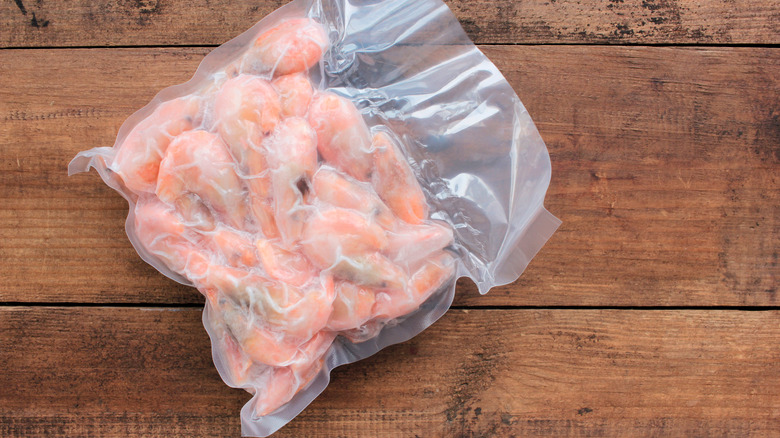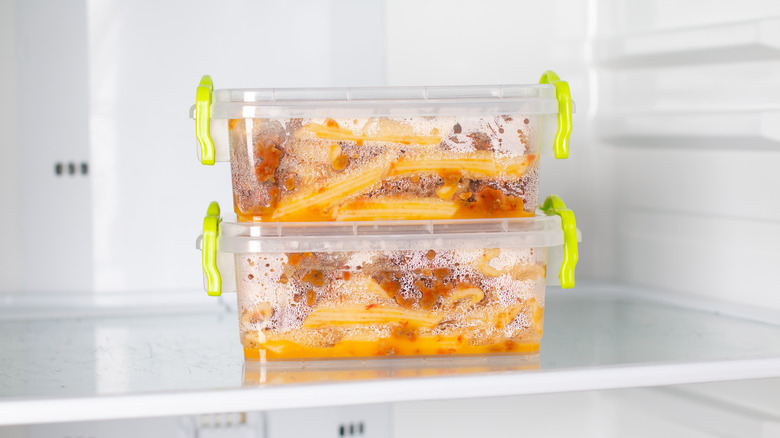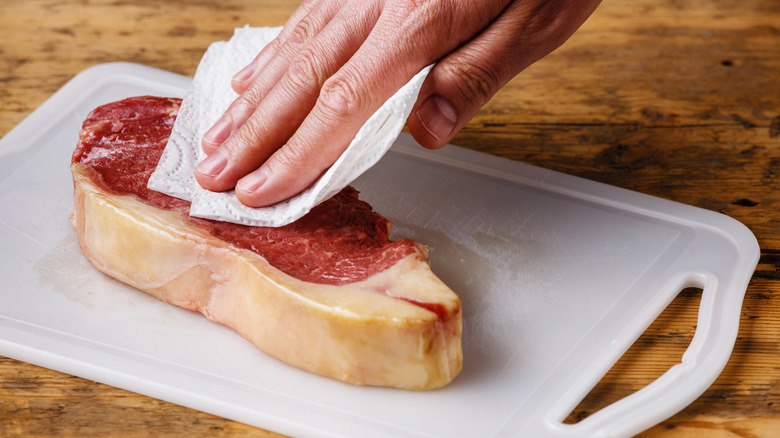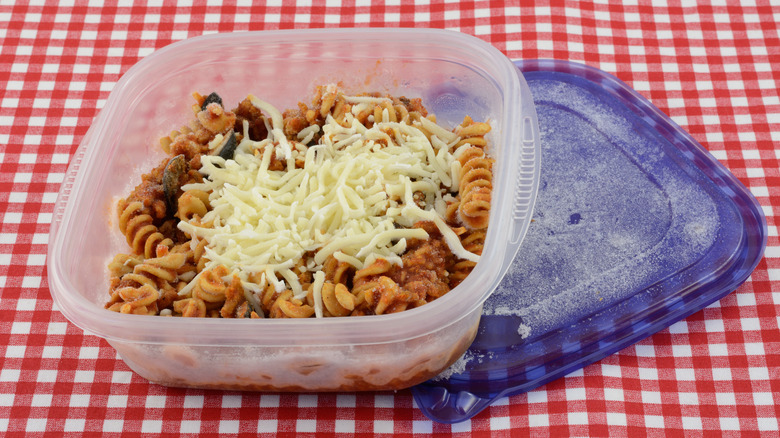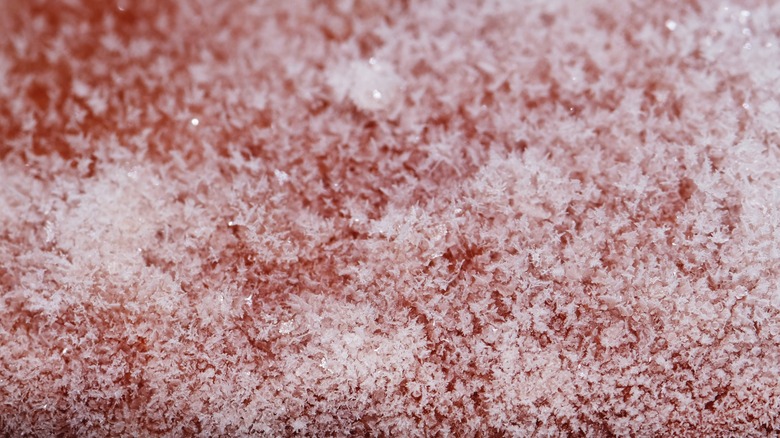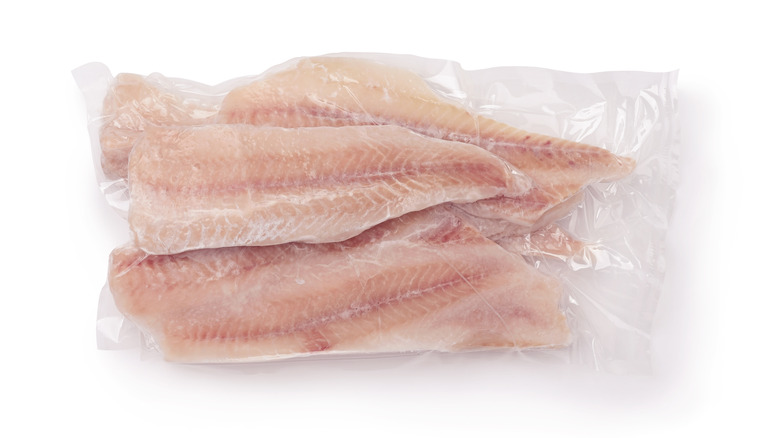Everything You Need To Know About Freezing Meat
Over time, prices at the grocery store always go up. When they rise sharply, it makes a lot more sense to shop in bulk: Most grocers offer lower prices per pound on the "family packs" of meat. However, buying large quantities of meat leads to the problem of where to store it. A freezer is always a great option.
Of course, you could just pop your package of meat in the freezer and take it out when you're ready. However, a few common frozen food mistakes can degrade the quality of frozen meat. Also, there are a few things to consider for optimal cooking results. Things like pre-portioning your meat, wrapping your meat properly, correct defrosting, and cooking correctly after defrosting can go a long way to getting the most out of both your meat and your freezer.
It's also important to point out that freezing meat isn't completely foolproof. A freezer won't save meat that's starting to go bad. A prolonged power outage can be devastating to your prized frozen steaks and hamburger patties. Keep reading to find out more ins and outs of freezing meat.
Minimize ice crystals by freezing meat quickly
You might think of freezing as a way to keep meat from spoiling. However, a better way to think about freezing is as a way to preserve freshness. Freezing meat quickly helps to lock in freshness. One of the worst things you can do is leave your meat out so it gets warm, and then try to freeze it, elongating the freezing process.
The problem with meat freezing slowly is the increased risk of ice crystal formation (via the USDA). When meat freezes quickly, water molecules don't have adequate time to form large crystals. If, however, large networks of disruptive ice crystals are allowed to form, it is detrimental to the meat's texture and flavor. Thawed meat that had extensive ice crystal formation will "bleed" significantly, resulting in a loss of juiciness. If you are freezing meat as part of a casserole or other dish, freezing can disrupt any cream-based emulsions, ruining the dish.
Check the temperature of your freezer
If you open your freezer door and everything appears to be frozen, no one would blame you for not giving it a second thought. But it is possible that meat stored in your freezer isn't being maintained at the right temperature. If food is blocking your freezer's fan or you have significant frost buildup, the freezer may not be maintaining the right temperature throughout the entire icebox.
To keep foodborne pathogens from reproducing and spoiling your meat, your freezer must be kept at 0 F. Don't just trust that your freezer is maintaining the right temperature. Buy a couple of freezer-specific thermometers and place them at opposite ends of your icebox. Periodically check the temperature to make sure your freezer is maintaining 0 F. If you happen to lose power, the thermometers can let you know if your freezer temperature drifts above 40 F for more than two hours. If it does not cross this red line, your meat is still safe to eat or refreeze.
Pre-portion for convenience and minimizing food waste
In the United States, about 20 pounds of food per person per month goes uneaten. That translates to more than $160 billion in food waste each year, according to the FDA. Food waste is also an environmental issue. It is the second biggest landfill component and a major methane source (a greenhouse gas).
While there are many ways to reduce food waste, pre-portioning your meat before freezing is one effective approach. It also makes cooking a little bit easier. WebMD notes that the correct portion of cooked meat is 3 ounces. Because meat loses about 25 percent of its weight when cooked, portion out about 4 ounces of meat per person per meal. For instance, if you have three meat eaters in your household, you should have meal portions of 12 ounces. Making individual portions of 4 ounces takes a bit of extra work, but it does allow for more mealtime versatility and faster defrosting.
Wrap meat tightly
If you can successfully keep your meat from any exposure to oxygen while in the freezer, it will help to support a long shelf life. There are a few common mistakes with frozen meat, and one of the biggest is allowing for exposure to oxygen. Taking all of the oxygen out of a standard freezer bag is difficult. A vacuum sealer can be a good investment if you expect to do a lot of freezing. A vacuum sealer is also an essential piece of equipment if you plan on cooking sous vide.
If you aren't going to invest in a vacuum sealer, wrapping the meat and placing it in a freezer bag can help to protect it from freezer burn-causing oxygen. Begin by removing any styrofoam or moisture-absorbing inserts. Then, wrap each portion of meat in a combination of plastic wrap and either aluminum foil or parchment paper. Place each wrapped portion in a resealable plastic bag and press out as much air as possible before closing the seal. If you do not have resealable plastic bags, you can use resealable plastic containers. Never use glass containers to store frozen items because rapid temperature changes can cause them to crack.
Label your bags or storage containers with the type of meat and date of purchase. This extra little step can ensure that you are properly rotating meat in and out of your freezer, ensuring the oldest meat gets cooked first.
Defrost properly
One of the biggest mistakes people make when defrosting meat is not giving it enough time. If you're in a rush, you could defrost meat by microwaving it or running it under hot water. However, this can lead to uneven defrosting and even unintentional cooking. Rushing defrosting by placing raw meat on a countertop can also lead to food safety issues.
The safest approach to properly defrosting frozen meat is allowing it to thaw over 24 hours inside a refrigerator. Even if it is defrosting in a well-sealed bag or container, frozen meat should be placed on a plate or other container to catch any juices that might be released. Defrosting meat should also be placed on the bottom shelf of a refrigerator so any juices that are released will not drip onto other foods and cause cross-contamination.
If you don't have an entire day to thaw frozen meat, the US Food Safety and Inspection Service (FSIS) says it is safe to defrost more quickly using cold water. First, ensure your meat is in a leakproof package or bag. Submerge your container or bag in cold tap water. Change the water every 30 minutes as the meat continues to thaw. Portions of meat less than 1 pound will thaw using this method in an hour or less. Portions weighing multiple pounds will take two or three hours. Be sure to cook immediately after the meat has completely thawed.
Remove moisture from steaks before cooking
Is there anything worse than getting a good deal on a bulk pack of steaks, freezing the steaks, thawing them, cooking them, and then having your steaks turn a weird gray color? One of the best parts of eating a steak is appreciating that signature brown crust and flavor-enhancing sear. If you don't take care of your steaks, you aren't going to get that essential sear and color.
Defrosting steaks can cause them to become wet on the outside. If you don't remove that moisture before throwing a thawed steak on the grill, by simply blotting it with paper towels, you will cause your steak to cook with steam heat — turning it gray. It's important to note that there's nothing wrong with a steak that has turned gray from cooking. It's just not as appealing.
Beef can also be gray before it is even cooked. When a protein in beef called myoglobin is exposed to oxygen, an oxidization reaction occurs, causing it to turn red. If the interior of a cut or package of beef hasn't been sufficiently exposed to oxygen, it will be greyish. Unless your grey beef has an unpleasant odor or slimy film, it should still be safe to eat (via Healthline).
Freeze cooked meat and meat dishes
Cooked meat, including lunch meat, might be one of those foods you didn't know you could freeze, but can be frozen in the same way you would freeze raw meat. You can also freeze cooked casseroles and other meat dishes with just a few additional considerations.
Cooked meat should be frozen the same day it was prepared. Before placing a container of cooked meat or a dish containing cooked meat into your freezer, be sure it has cooled to at least room temperature. Adding hot food to a freezer will cause it to warm up, possibly warming other foods in the freezer to the point of causing a food safety issue.
It is also perfectly safe to freeze soups, stews, and casseroles containing cooked meat. Avoid freezing dishes containing prepared dishes that contained raw meat. Portioning out cooked dishes can both reduce the time needed to freeze and make reheating easier. Casseroles containing cooked meat can be stored for up to three months, according to experts at Michigan State University. Keep in mind that you probably shouldn't freeze casseroles with dairy, as the freezing process will break any dairy-based emulsion.
Be on the lookout for red flags
While freezing meat is mostly a set-it-and-forget-it affair, there are a few red flags to indicate when you should throw away frozen meat. The USDA has created a freezer storage chart that is an essential resource for determining if frozen meat is still good to eat. The chart lays out how long meat and other foods will last if kept in a freezer. It's important to note that using this chart requires adequate labeling and proper freezer storage.
If you lose power, try not to open your freezer until power is restored. Once power has returned, check your freezer's internal temperature. If it is above 40 F and you suspect it may have been above that temperature for at least two hours, the USDA recommends tossing any meat you may have been storing.
Smell, texture, and color are also reliable indicators. If a piece of meat smells bad while it's frozen or after it's defrosted, get rid of it. If a frozen or thawed piece of meat has an unnatural texture, throw it out. If something takes on strange color when frozen, it's a sign that your meat may be losing its quality. In this situation, meat may be still safe to eat, according to the USDA, but you still may want to throw it out. In all of these situations, it's best to air on the side of caution and get rid of any meat you suspect may have gone bad.
Don't keep meat frozen for too long
Although it's reportedly safe to eat wooly mammoth meat that's been frozen for tens of thousands of years, it supposedly doesn't taste all that great. The same goes for ground beef, pork shoulder, or other meats that are left in your freezer for too long. While it is safe to eat 2-year-old frozen meat, you should probably just give up the ghost and move on.
Food that is starting to go bad cannot be saved by freezing. If it is frozen fresh, food stored at 0 F will always be safe to eat, according to the FSIS. The main concern then is preserving freshness and quality. Cuts of meat can last up to a year in the freezer and maintain their quality. Ground meat is only good for a couple of months.
Also, it's important to note that frost-free freezers will periodically raise the temperature of the freezer from 0 to 32 F. Over the short term, this isn't anything to worry about, but over the course of many months, repeated temperature fluctuations could cause damaging ice crystals to form.
